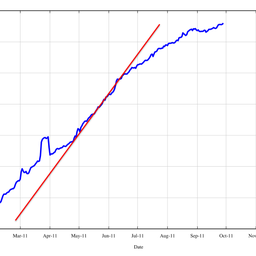The size of the global routing table has been growing at a constant pace for many years. However, over the last few months, it is not growing as fast as it used to.
Please also see the follow-up article: Routing IPv6 in 2011 .
Every address prefix that is reachable on the Internet, is listed in the routing system, and as the Internet grows so does the number of routes.
There have been a number of efforts to undertake long term measurement of the routing environment, and the Regional Internet Registries (RIRs), notably the RIPE NCC and APNIC, have been performing regular measurement of the routing system for many years now.
The figure below show a plot of the number of entries seen in the routing system every hour since the start of 2011. The particular viewpoint here is taken from APNIC, using a router located in Australia, but much the same picture is available anywhere on the Internet, as the entire objective of the routing system is to broadcast a consistent picture of reachability to all points on the Internet.

So lets look at what we can see in this figure. This is a classic "up and to the right" Internet curve. But it’s not quite the curves we've been seeing for many years. In the Internet we've grown used to curves that are strong "J curves." When something is growing very quickly, such as when a metric doubles every year, then this explosive growth generates a curve that grows upwards sharply to the right. In systems that are growing exponentially the majority of the growth happens in the most recent period.
The routing system has grown at exponential rates, and from time to time we have been very concerned about the rate of growth of routing, but these periods of explosive growth have not happened for some time. We saw exponential growth in the routing system from 1997 to 2001, over the time of the first so-called "Internet boom". And it occurred a second time from 2004 to 2007, which corresponded to the transformation of the Internet with the twin pressures of expansion of the Internet into the massively developing Asian economies and the explosive growth of the mobile Internet sector with the uptake of iphones, Android devices and similar. However, the financial crisis of 2008 saw this second phase of exponential growth come to a stop, and these days the growth of the Internet, and the Internet's routing table in particular is along a slower and steadier trajectory.
For the first four months of 2011 the routing table has been growing at a steady rate of some 5,000 new routing entries each month. But then at the end of April of this year something changed. And what changed was that in the Asia Pacific region, APNIC, the RIR serving that region, effectively exhausted its stocks of available IPv4 addresses. The impact of this on the regional Internet was immediate, if the routing table is a good indicator.
However, the reaction to exhaustion was not an immediate upward spike in the number of routing table entries, as some folk have been predicting, but the opposite, in that the rate of growth in the routing system has slowed since then. In the ensuing 5 months the routing system has grown by a little over 2,000 new entries each month. But is this all due to the exhaustion of IPv4 addresses in the Asia Pacific region? Perhaps not. In these months we have witnessed round two of a major financial recession in many parts of the world, and the economic uncertainty has disrupted many plans for deployment of new products and services on the Internet.
The continued sluggish rate of routing growth in the Internet in the past few months may have as much to do with the adverse economic conditions in many parts of the world as it has to do with the change of the IPv4 Internet growth model in the Asia Pacific region.
A suite of tools to look at the routing system, both from a large scale perspective and in very minute detail, can be found at the RIPE NCC Routing Information System (RIS): http://ris.ripe.net






Comments 4
The comments section is closed for articles published more than a year ago. If you'd like to inform us of any issues, please contact us.
Anonymous •
quite a surprising result...it will be very interesting to see if this trend continues during the next year or so<br />
Anonymous •
Doubtless the economic downturn will come to an end in time, but its an open question about the impacts of address exhaustion and the address aftermarket on the routing table. It's also the case that an economic recovery, if it occurs in the coming months, will increase the level of consumption pressure on the remaining pools of addresses in the North American and European regions, so the larger picture here of network growth and its impact on the size of the routing system is an interesting question.
Anonymous •
Geoff. Hi and thanks for this insight. Is the v6 table included in this? Would the v6 table size curve in any way pick up where the v4 curve "left off"? Maybe I'm being too hopeful!
Anonymous •
The IPv6 table is not included in this. Actually it's a very different story and while it has the same elements of the April APNIC Exhaustion and some financial woes that are impacting this industry, there are a couple of additional elements in the IPv6 story, not the least of which was the efforts in preparation for World IPv6 Day in June. Maybe that story is best told in another article, coming soon!